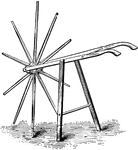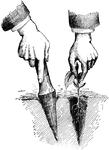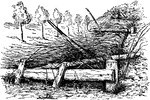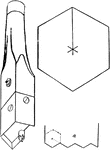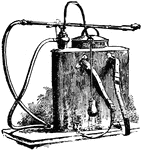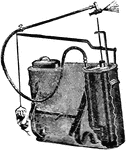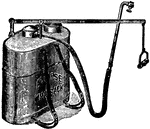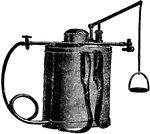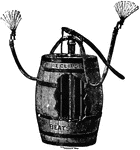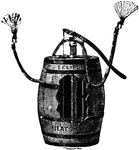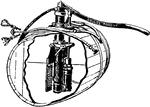Sulphurator
"Sulphurators are instruments for distributing flowers of sulphur, for the purpose of destroying mildew.…

Epps's Sulphurator
"Sulphurators are instruments for distributing flowers of sulphur, for the purpose of destroying mildew.…
Suckering Iron
"Root suckers are young shoots from the roots of plants, chiefly woody plants, as may often be seenin…

Root-Grafting
"In the case of large woody plants thus worked the grafted roots, after the operation is completed,…
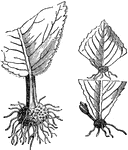
Leaf Cuttings
"Many plans may be propagated by planting their leaves or portions of their leaves as cuttings, as,…
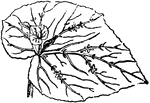
Leaf Cuttings
"Many plans may be propagated by planting their leaves or portions of their leaves as cuttings, as,…

Pelargoniums
"Some plants, like pelargoniums, can only be kept handsomely formed and well furnished by cutting them…
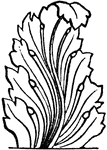
Acanthus
"The name given by the Greeks and Romans to the plants sometimes called Brancursine, of which it is…

American Aloe
Stiff plants with large, thick leaves. It is said to have medicinal purposes for burned or damaged skin.

Agrimony
"A genus of plants of the natural order rosacae, sub-order Potentilleae. The calyx is five-cleft, without…

Amaranth
"A genus of plants of the natural order Amaranthaceae. This order contains nearly 300 known species,…

Anacharis
"A genus of plants of the natural order Hydrocharideae, of which a species A. Canadensis has recently…

Andromeda
"A genus of Andromeda polifolia of plants of the natural order Ericaceae, distinguished by a 5-valve…
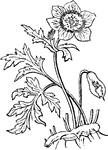
Anemone Coronaria
"A genus of plants of the natural order Ranunculaceae, having an involucre of three divided leaves,…

Angelica
"A genus of plants of the natural order Umbelliferae, by some botanists divided into two: A., and Archangelica.…
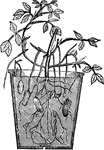
Arachis
"A genus of plants of the natural order Leguminosae, sub-order Papilionaceae, natives of the warm parts…

Arbor Vitae
"A genus of plants of the natural order Coniferae, allied to the cypress, and consisting of evergreen…

Aristolochia
"A genus of plants of the natural order Aristolochiaceae. This order, which is dicotyledonous or exogenous,…
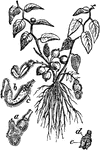
Aristolochia
"A genus of plants of the natural order Aristolochiaceae. This order, which is dicotyledonous or exogenous,…

Arnica Montana
"A genus of plants belonging to the natural order compositae, sub-order Corymbiferae. The flowers of…

Bread-fruit
"Artocarpaceae, a natural order of Dicotyledonous plants, of which the Bread-fruit is the type; very…

Basil
"A genus of plants of the natural order Labiatae. The species are all natives of the tropics, or of…

Rock-Rose
"A genus of exogenous plants, which gives its name to the natural order Cistaceae; an order allied to…

Clematis
"A genus of plants of the natural order ranuculaceae having four colored sepals, no corolla, and fruit…
Colchicum
"A genus of plants of the natural order Melanthaceae. The species, which are few in number, are stemless,…
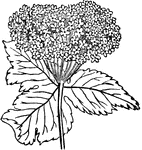
Cow Parsnip
"A genus of plants of the natural order Umbelliferae, having petals bent in at the middle, and flat…

Cress
"A name given to many plants, of which the foliage has a pungent, mustard-like taste, and is used as…

Daphne Mezereon
"A genus of plants of the natural order Thymeleaceae, having a 4-cleft, funnel-shaped perianth, the…
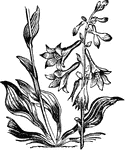
Day-lily
"A genus of plants of the natural order Liliaceae, having a perianth with bell-shaped limb, and sub-cylindrical…
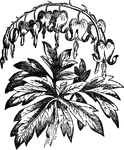
Dielytra
"A genus of plants of the natural order Fumariaceae, in appearance and habit much resembling fumitories…
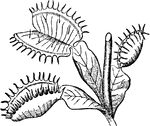
Dionaea
"A very curious and interesting genus of plants of the natural order Droseraceae, having a 5-partite…

Dittany
"A genus of plants of the natural order Rutaceae, having a short 5-partite calx, five some-what unequal…

Capsicum
"A genus of annual, subshrubby plants, order Solanaceae, with a wheel-shaped corolla, projecting and…

Jasmine
"Botanically Jasminum, a genus of shrubs or climbers constituting the principal part of the natural…

Deming
A portable barrel outfit, called a Deming kerosene emulsion knapsack used to spray insecticide
